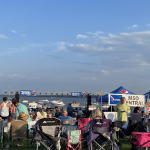As water levels rise along the Mississippi River, threatening flooding, Lt. Governor Delbert Hosemann is urging the U.S. Army Corps of Engineers (USACE) to exhaust all possible flood control options before considering opening the Bonnet Carré spillway.
Officials are gearing up for the river to reach its highest levels in recent years near New Orleans and Baton Rouge, Louisiana, prompting concerns of the infamous Bonnet Carré Spillway being utilized to reduce flood concerns.

Hosemann, recognizing the detrimental impact the spillway’s various openings have had on aquatic life in the Mississippi Sound and the region’s economy, is asking the USACE to refrain from introducing fresh water from the Mississippi River into the saltwater body. Instead, he is calling on the federal agency to utilize other water diversion methods.
“Repeated diversions of Mississippi River freshwater into the Mississippi Sound have devastated Mississippi’s coastal ecosystem, crippled our seafood industry, endangered public health, and severely harmed our tourism economy,” Hosemann wrote in a letter penned to Col. Cullen A. Jones, the Commander & District Engineer of the USACE’s New Orleans District.
“The cumulative damage is no longer tolerable and cannot be justified by the Corps’ singular focus on flood diversion by this sole matter at the expense of an entire neighboring state.”
The Bonnet Carré sits in Laplace, Louisiana, near New Orleans. Its openings, per the Institute for Marine Mammal Studies and the Mississippi Department of Environmental Quality, have wreaked havoc on the Mississippi Sound. Studies from both agencies indicate that marine life in the Mississippi Sound is continuing to suffer the effects of its habitat being altered by a different type of water flooding in.
Instead of opening the Bonnet Carré Spillway, Hosemann and Mississippi wildlife advocates have offered the following alternatives:
- Immediate utilization of the Morganza Spillway to direct excess flow through the Atchafalaya Basin instead of into the Mississippi Sound
- Emergency dredging of the Mississippi River both south of the Bonnet Carré and near the river’s mouth to increase conveyance and avoid spillway use
- Utilization of the Old River control structure for diversion of flood waters prior to reaching the Bonnet Carré
- Coordinated, timed reservoir releases upriver to flatten flood peaks before they reach the lower valley
“Mississippi is willing to partner on engineering evaluations, restoration plans, and infrastructure enhancements to achieve a more equitable and scientifically sound approach. But we will no longer silently bear the brunt of decisions made without regard to our waters, our wildlife, and our citizens,” Hosemann added.
“If this federal decision-making process continues to ignore Mississippi’s rights and interests, as well as the devastating effects on marine life, we will pursue every legal and political remedy available.”
Hosemann requested a written response from the USACE entailing its alternatives analysis, the decision-making timeline, and regional impacts beyond the New Orleans floodplain. His hope is that the federal agency will not haphazardly destroy sea life in the Mississippi Sound without first exhausting all possible substitute options.
Backstory
In 2019, Mississippi River levels were predicted to rise to a minor flood stage in New Orleans. The Bonnet Carré Spillway was opened on February 27 and again on May 10 for a total of 123 days. The Spillway had never been opened twice in one year, and never for such a long period.
Polluted water from the Spillway is believed to have killed more than 90% of oysters on Mississippi harvest reefs. Shrimp landings were reduced by 50% due to large quantities of fresh water from the Mississippi River being introduced into the Mississippi Sound.
This prompted a lawsuit filed by an alliance of local governments, businesses, and organizations — the Mississippi Sound Coalition. A federal court sided with the alliance and ruled that the openings of the Bonnet Carré Spillway did, in fact, harm marine life in the region. Area businesses also lost an estimated $20 million due to the loss of aquatic species.
As a result, the U.S. Army Corps of Engineers was ordered to consult with the National Oceanic and Atmospheric Administration before reopening the spillway to avoid further damage to marine species.
The Mississippi Department of Marine Resources opened its first round of financial assistance applications due to the 2019 blunder in August 2023 and dished out roughly $6.57 million to eligible commercial fishermen and dealers. Another round of applications opened in October 2024.







